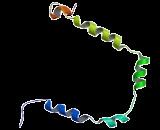Species Human Entrez 345 | Human Mouse Ensembl ENSG00000110245 | |
 | ||
Aliases APOC3, APOCIII, HALP2, apolipoprotein C3 External IDs OMIM: 107720 HomoloGene: 81615 GeneCards: APOC3 | ||
Apolipoprotein C-III also known as apo-CIII is a protein that in humans is encoded by the APOC3 gene. Apo-CIII is a component of very low density lipoprotein (VLDL).
Contents
Structure
ApoCIII is a relatively small protein containing 79 amino acids that can be glycosylated at threonine-74. The most abundant glycoforms are characterized by an O-linked disaccharide galactose linked to N-acetylgalactosamine (Gal- GalNAc), further modified with up to 2 sialic acid residues. Less abundant glycoforms are characterized by more complex and fucosylated glycan moieties.
Function
APOC3 inhibits lipoprotein lipase and hepatic lipase; it is thought to inhibit hepatic uptake of triglyceride-rich particles. The APOA1, APOC3 and APOA4 genes are closely linked in both rat and human genomes. The A-I and A-IV genes are transcribed from the same strand, while the A-1 and C-III genes are convergently transcribed. An increase in apoC-III levels induces the development of hypertriglyceridemia. Recent evidences suggest an intracellular role for Apo-CIII in promoting the assembly and secretion of triglyceride-rich VLDL particles from hepatic cells under lipid-rich conditions. However, two naturally occurring point mutations in human apoC3 coding sequence, namely Ala23Thr and Lys58Glu have been shown to abolish the intracellular assembly and secretion of triglyceride-rich VLDL particles from hepatic cells.
Clinical significance
Two novel susceptibility haplotypes (specifically, P2-S2-X1 and P1-S2-X1) have been discovered in ApoAI-CIII-AIV gene cluster on chromosome 11q23; these confer approximately threefold higher risk of coronary heart disease in normal as well as non-insulin diabetes mellitus. Apo-CIII delays the catabolism of triglyceride rich particles. Elevations of Apo-CIII found in genetic variation studies may predispose patients to non-alcoholic fatty liver disease.
Interactive pathway map
Click on genes, proteins and metabolites below to link to respective articles.
